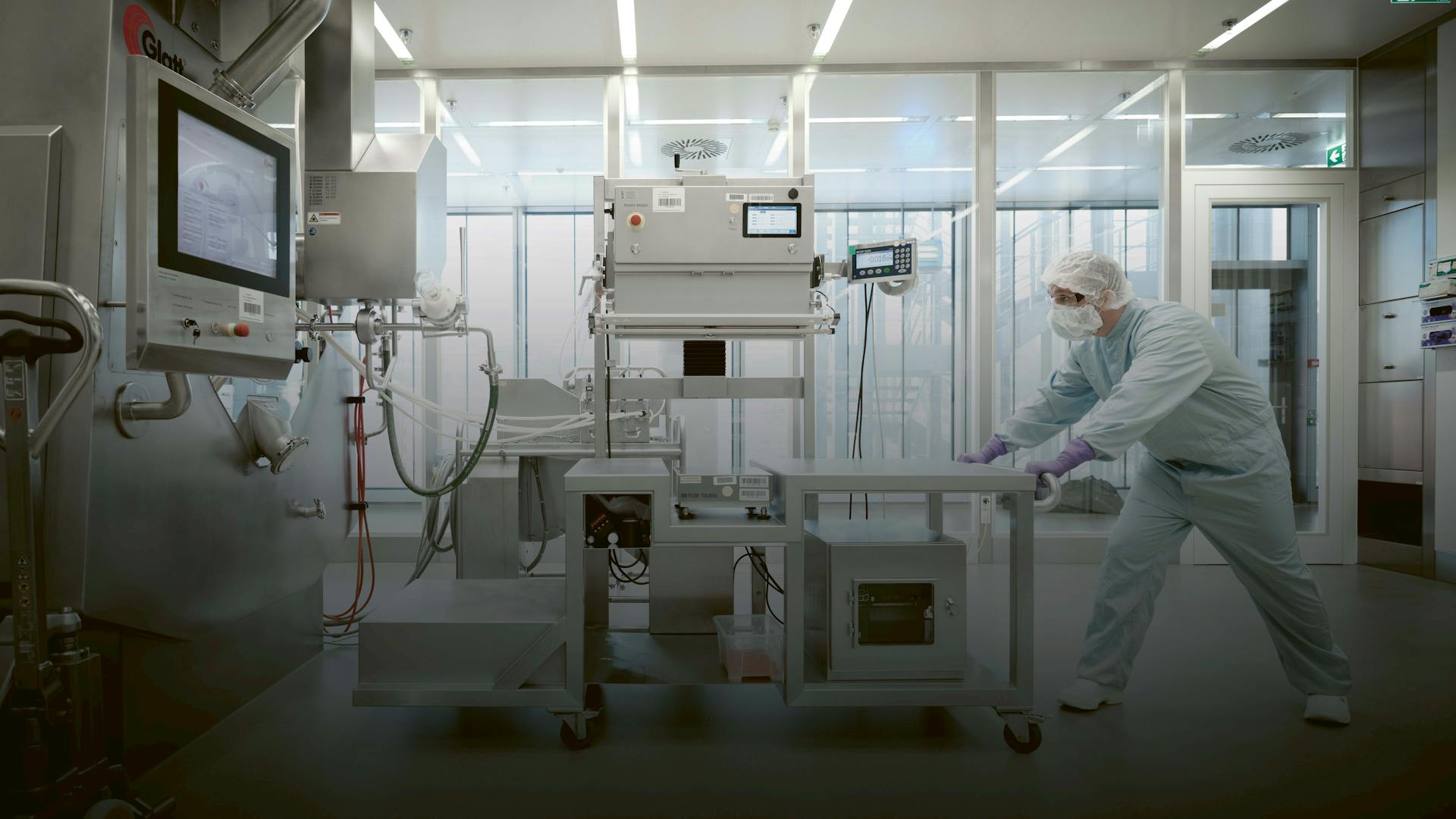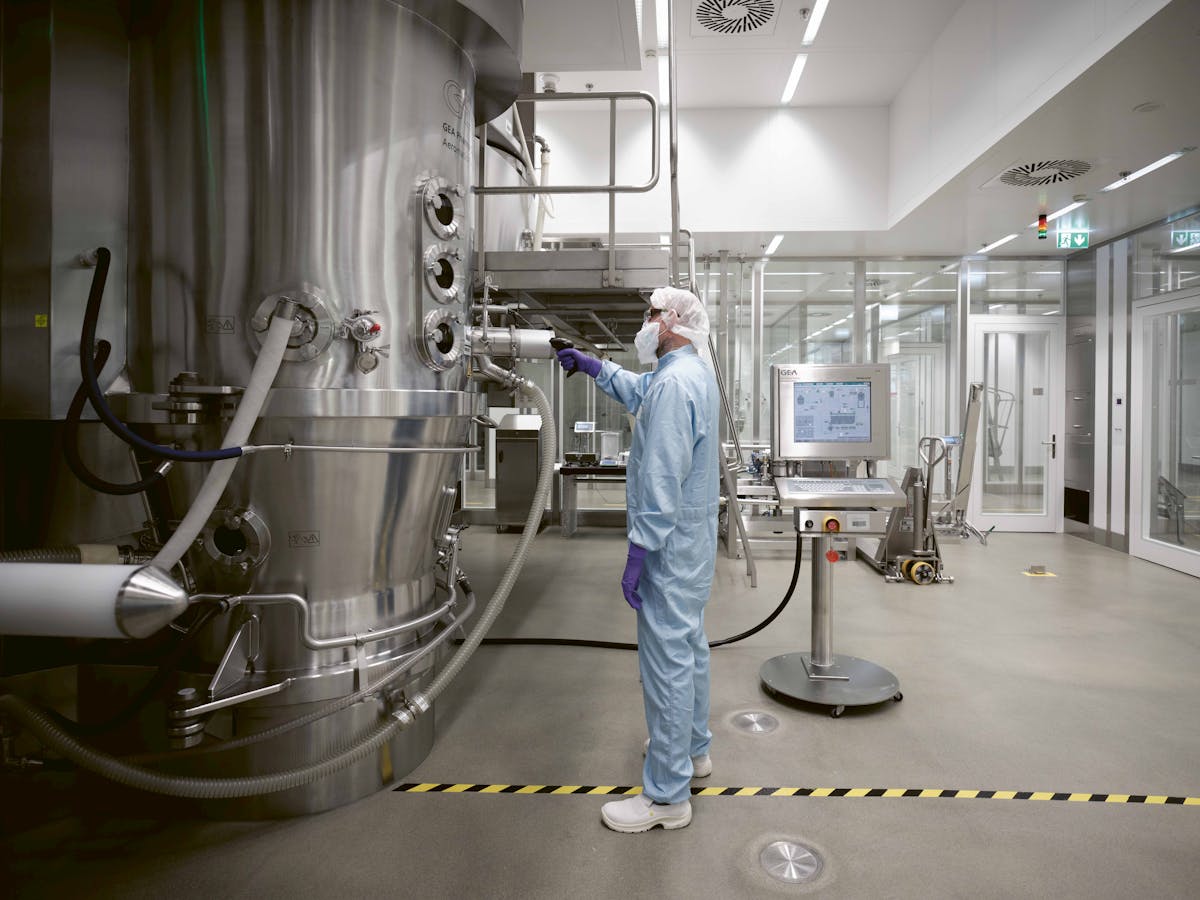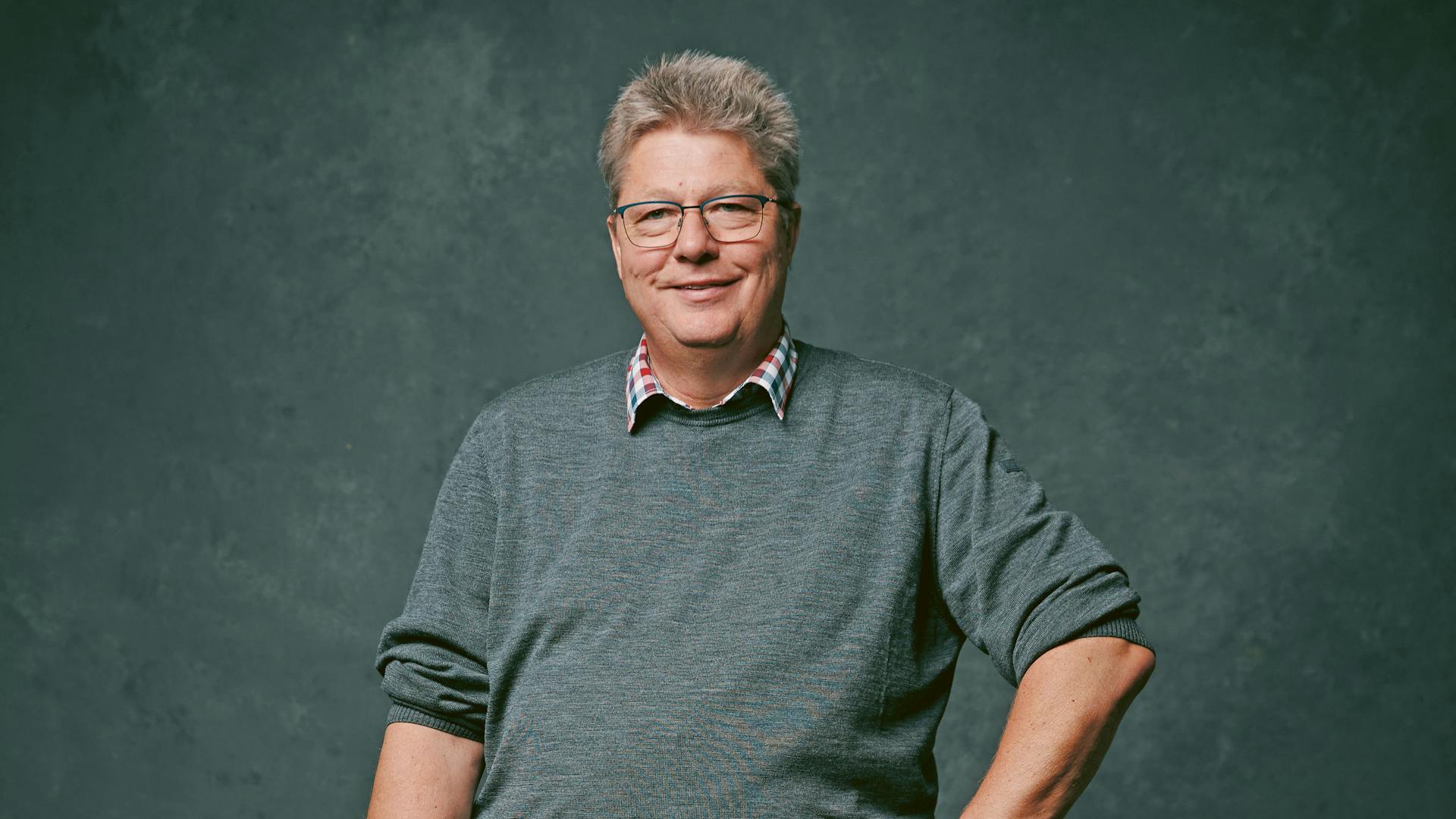
From paper to cloud
Pharmaceutical products have been manufactured at the Swiss site in Stein for more than 60 years. To ensure that the site remains competitive, facilities and processes need to be continuously refined. For employees, this culture of permanent change brings new opportunities, but also challenges.
Text by Michael Mildner, photos by Bjoern Myhre





Production of solid dosage forms in the WST-222 high-shear mixer and fluidized bed dryer.
 Table of contents
Table of contents Fitness for man and machine
Fitness for man and machine The master maker of sugar-coated tablets and Co.
The master maker of sugar-coated tablets and Co. The scanner replaces the pen
The scanner replaces the pen And what does the future hold?
And what does the future hold?Published on 24/07/2023
Joining Ciba-Geigy was a demotion of sorts for Monika Stocker, if only geographically. She had spent the winter of 1986–1987 working as a service employee high up in the Swiss Alps, always in the fresh air and constantly on her feet. Back in the lowlands, she then sat for eight hours a day in the windowless basement of Building 110, where some 50 women checked ampoules.
“I’ll do that for six months at most,” she said on the evening of her first day on the job. “Sitting all the time, I can’t stand it.” Her discomfort was noticed quickly and her superiors were aware that Monika Stocker preferred to be on her feet rather than in a chair.
Just two months later, she switched to the contact lens cleanroom facility, and, two years down the road, she moved to the second floor, where the filling facility for ampoules is located. After a series of manufacturing jobs, however, Monika Stocker finally worked in the office until her retirement in 2021.
Was everything better in the past?
When asked about the wealth of experience she gained over more than 30 years in Stein, she is happy to provide information.
Was it better in the past than it is today, less stressful? “No, I wouldn’t call it better. During my time in production, I experienced many difficult situations. But we usually weathered the stormy times. Perhaps the camaraderie used to be a bit stronger, with more parties and events outside of work, but the physical strain decreased because a lot of things have been automated.”
What changed markedly, though, were the increased requirements for documentation and safety, Monika Stocker tells us. “Where once only a few pages were enough to document processes, later there were often mountains of paper piled up next to the equipment.”
Safety was also steadily improved. Monika Stocker has brought back photos from the 1980s and 1990s. There are three female colleagues sitting together in their protective clothing and smiling into the camera. “We also wore the bonnets for decoration back then,” she says. “For us, it was like a fashion accessory. Today, no one thinks that the protective clothing could have anything to do with fashion.”
Imre Bajusz, Manufacturing Unit Head in Sterile Packaging, has also experienced many changes since he trained as a chemical engineer some 30 years ago.
He still remembers his internship days at Sandoz, when he struggled to get acknowledged by his older colleagues and be given responsible tasks. “Back then, after three weeks in the lab, I was offered my first independent work: an extraction. Both delighted and excited, I accepted the offer. However, it was not quite what I had expected: I was only allowed to extract the coffee for the work break.”
Today, young trainees are given much more responsible tasks. However, work in general has also become more demanding. In his current role, he experiences the ever-increasing demands on quality and safety almost firsthand. Protective suits in all variations can be seen when walking through the halls. Protective clothes need to be changed constantly from zone to zone – a fitness workout that employees have to complete several times a day.
But the fitness of the technical equipment is also constantly tested. Since 2011, the aging equipment of the Steriles department in Stein has been continuously replaced. For example, the state-of-the-art isolator line for filling lyophilized vials started operation in 2015, and the new packaging building WST-303H was opened in 2017.
Additional investments have also been made: Recently, the first commercial prefilled syringe filling production line 14 started in Building 303. In September 2022, a new packaging line for autoinjectors was delivered.
Besides technology changes, regulatory demands have increased too, Imre Bajusz says. One example is the traceability of each pack from the manufacturing process to the pharmacy. “We can now also reduce the risks of drug counterfeiting and parallel imports. We have developed modern track-and-trace systems for our Steriles facilities that encode each package with a crypto code.”
The production manager, meanwhile, sees great opportunities in the continued digitalization. “It allows manufacturing teams at the site to simplify their processes while being supported by global operation centers that are geographically remote,” he says, adding that “technologically, it’s clearly moving toward more automation and robotization.”
Ruth Leu has only been working at the Stein plant for seven years, but she has seen her fair share of changes during her more than 30 years in the pharmaceutical industry. In her role as Manufacturing Unit Head Small Molecules, she manages the production and packaging of solid dosage forms. From conversations with long-time employees, she has been able to learn a lot about times gone by in her current field of activity – times when many things were also different, but not always better.
One relic from the past, for example, is the so-called snowball test. This was used to manually check whether granules were sufficiently moist and held together well. “Today, we measure the torque of the agitator blade in the high-speed mixer, and this measurement is an absolutely reliable criterion for finishing the granulation step,” Ruth Leu explains.
Until the end of the 1980s, the production of sugar-coated tablets required experience and feeling. “In those days, the master maker of sugar-coated tablets would walk along a seemingly endless battery of rotating copper kettles, check the mixture, and then throw one or two handfuls of the powder into certain kettles if the tablets threatened to stick there. The final composition could therefore only be given with theoretical values. Now tablets are coated with thin films whose composition and quantity are precisely defined,” she says.
Whereas in the early days of the plant there were several tableting machines in one room, a separate booth was later built for each machine. But even back then, employees still had to move from cubicle to cubicle with different products, exposing them to a corresponding contamination risk. “In the new WST-222 building, each manufacturing module now has its own separate material and personnel airlocks, and the changing or cleaning procedure makes cross-contamination impossible.”
However, Ruth Leu sees the greatest progress in data collection. “Today, the level of documentation detail is much greater than it used to be, and the manufacturing documents have become more and more extensive over time, currently between 150 and 250 pages per batch. However, as the volume increased, so did the susceptibility to errors. If poor data entry or omitted signatures were later discovered, that was a huge problem.”
Not only does the WST-222 now use an electronic documentation system, but the entire manufacturing process is completely paperless. This means that all production machines are also connected to an electronic documentation system. Logs are no longer printed out by the machines, but all data is collected electronically in a “data cloud.” This makes them much more readily available for problem-solving analyses and allows for more comprehensive investigation.
Safety has also increased further, explains Ruth Leu. “With the electronic system for documenting production, signatures can no longer be missing or steps skipped, as the system does not allow this.” Checking and approving the manufacturing documentation is thus also accelerated enormously. Compared to the detailed review of a 200-page paper documentation, this is truly a relief!
While human intuition and experience are being increasingly replaced by data processing, experienced and well-trained employees who know the products and plants well are still needed in order to react correctly when difficulties arise. Close teamwork and an intensive exchange of experience also remain important components for a smooth manufacturing process, Leu explains.
“However, this complete integration of production machines and fully automated data acquisition is only one of many innovations,” explains Ruth Leu. “With additional process analytical methods, we are continuously improving our understanding of the process. At the same time, more and more information is captured directly in the process rather than by sample train and post-production analytics.”
A concrete example is the sample train for quality checks, which in the past were usually done in a separate lab. “We are now replacing this procedure with NIR (near-infrared) technology, so that we can assess the development of the mix quality online during the process.”
But there is more in store. The online determination of the active ingredient content of the tablets is already being considered as a further development, and Ruth Leu says the release of the tablets directly from the tableting machine without additional analysis in quality control is the ultimate goal. “What sounds utopian today may soon become reality.”




